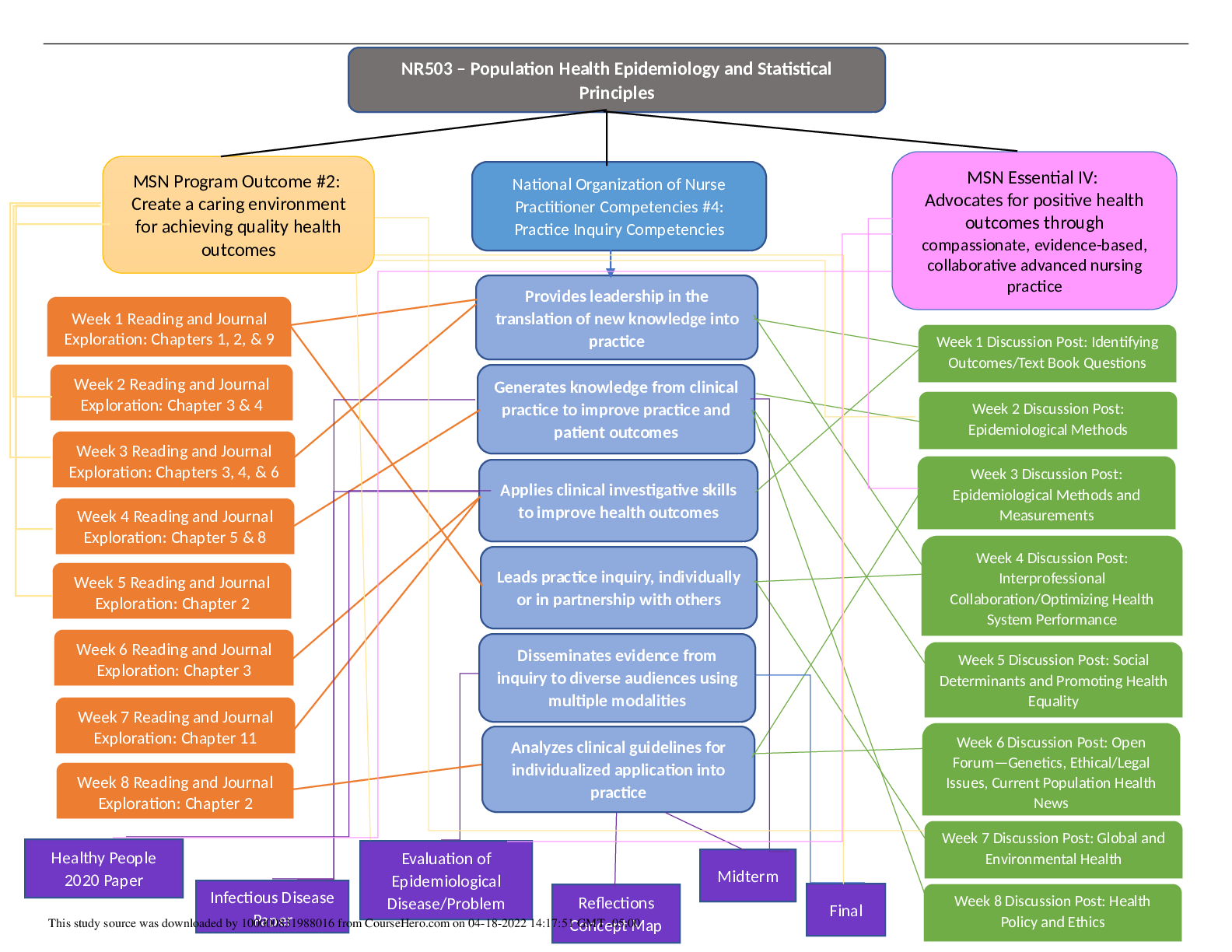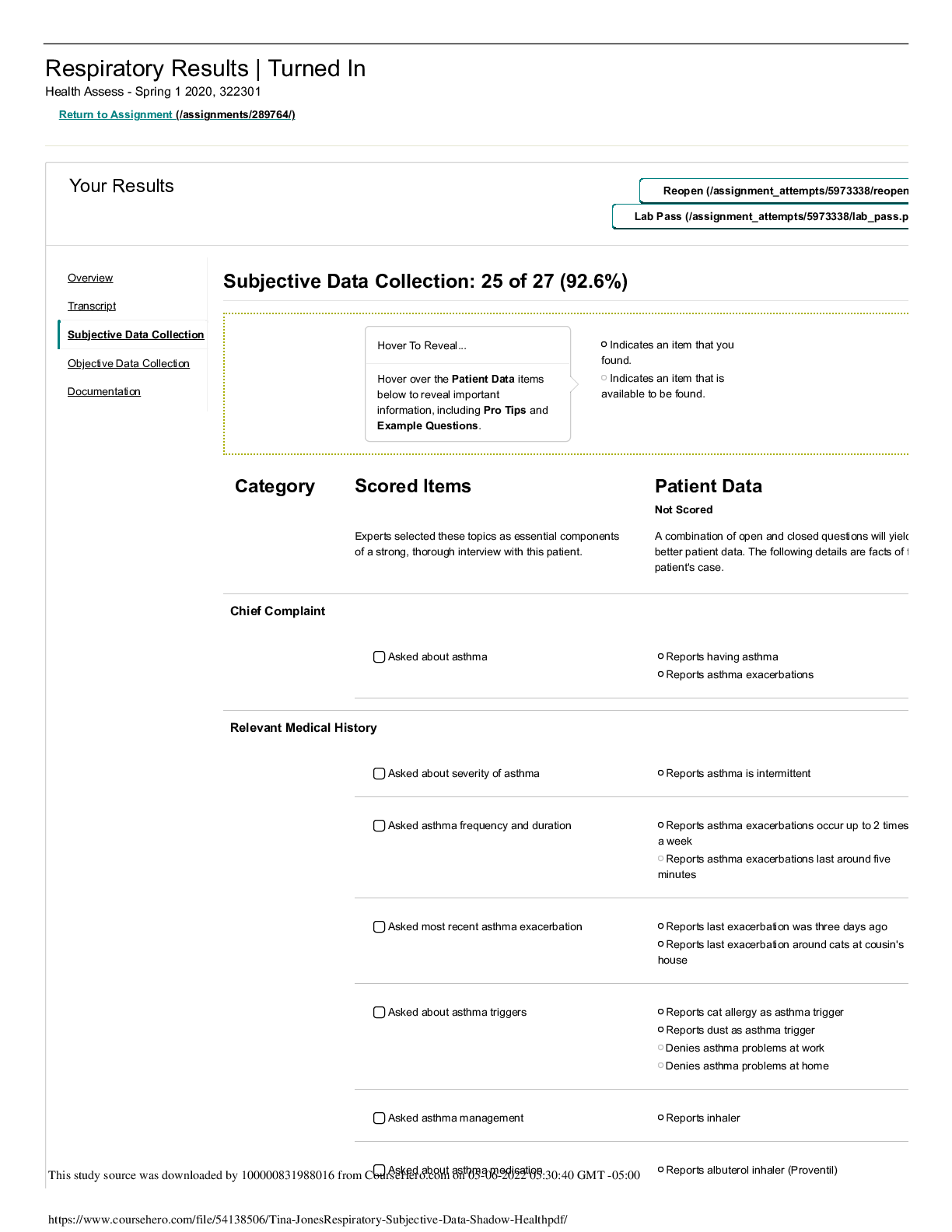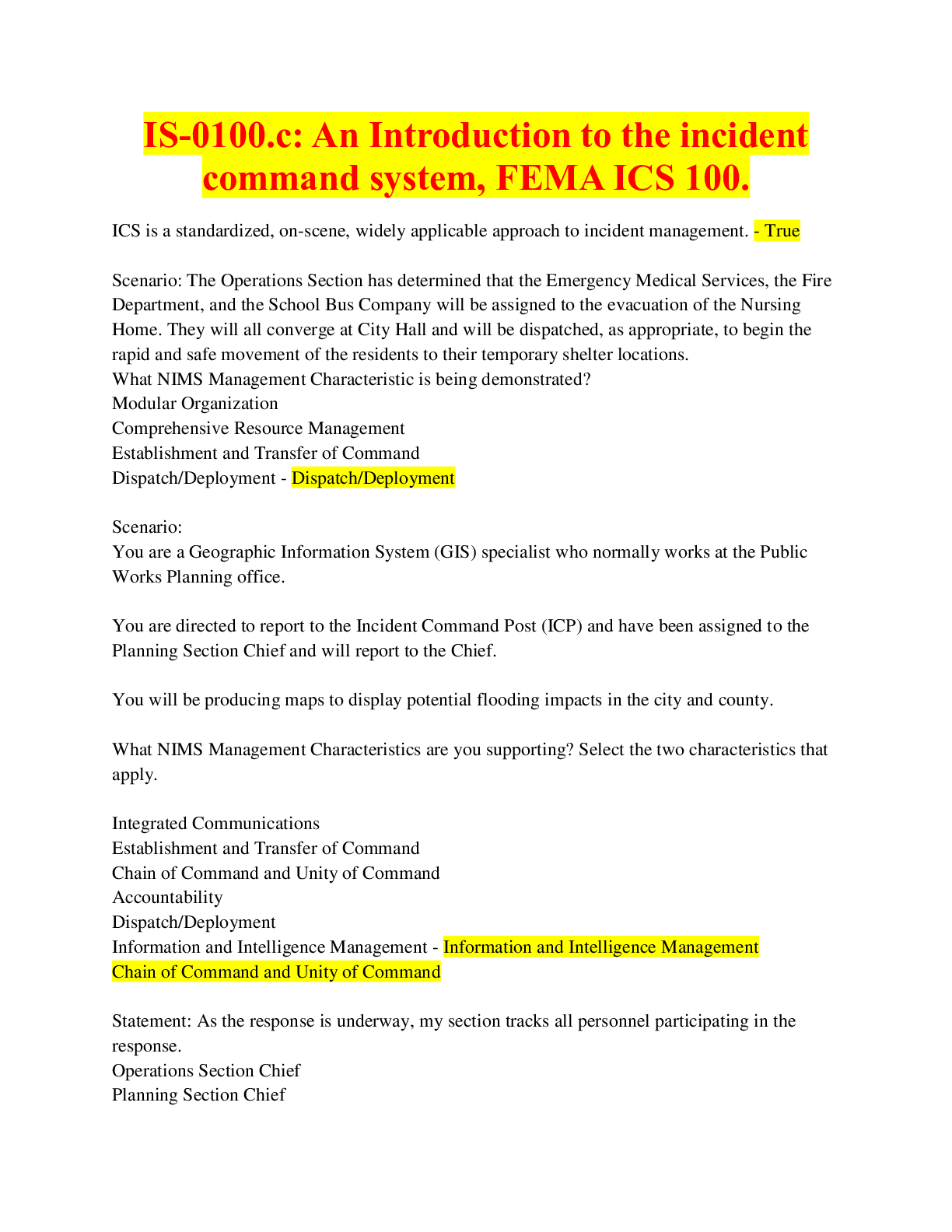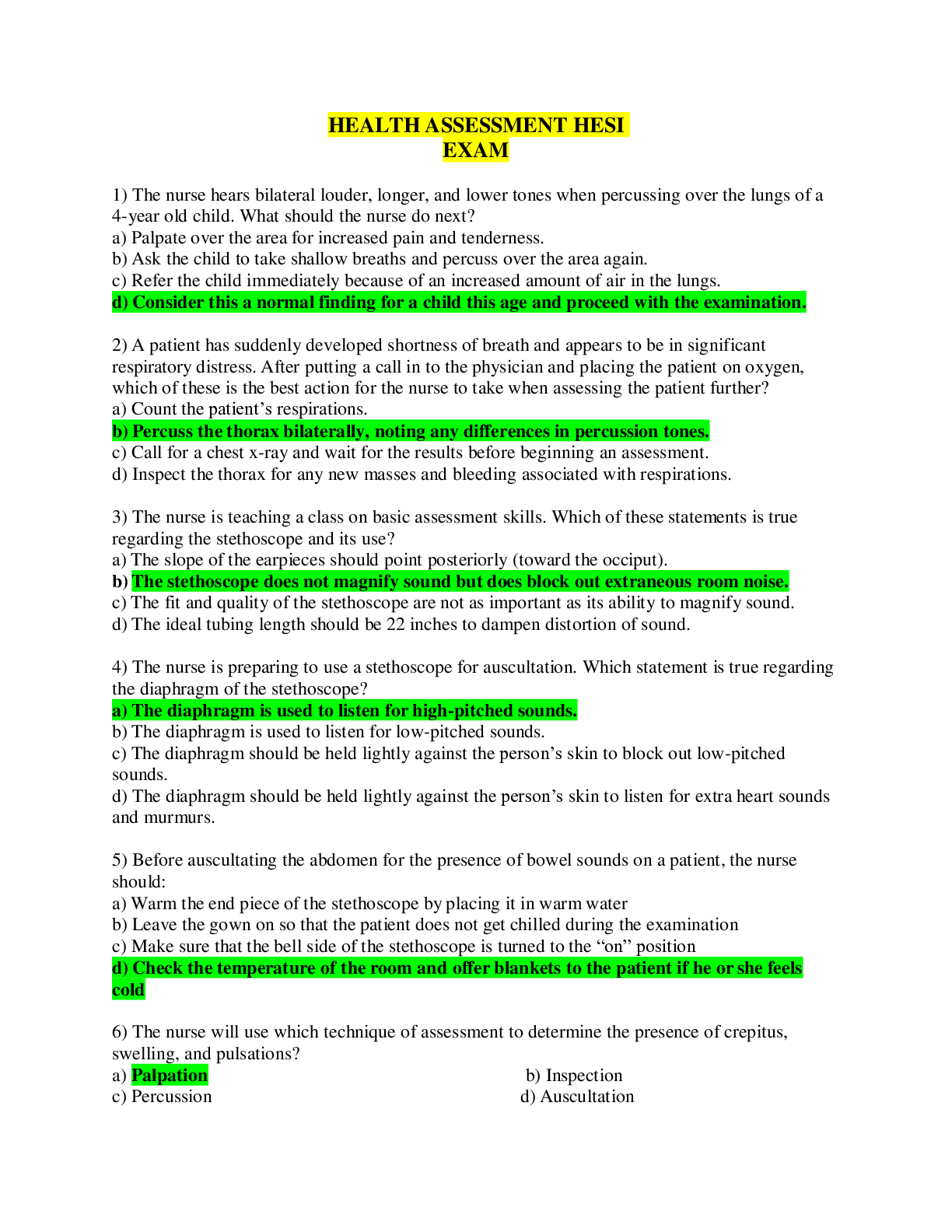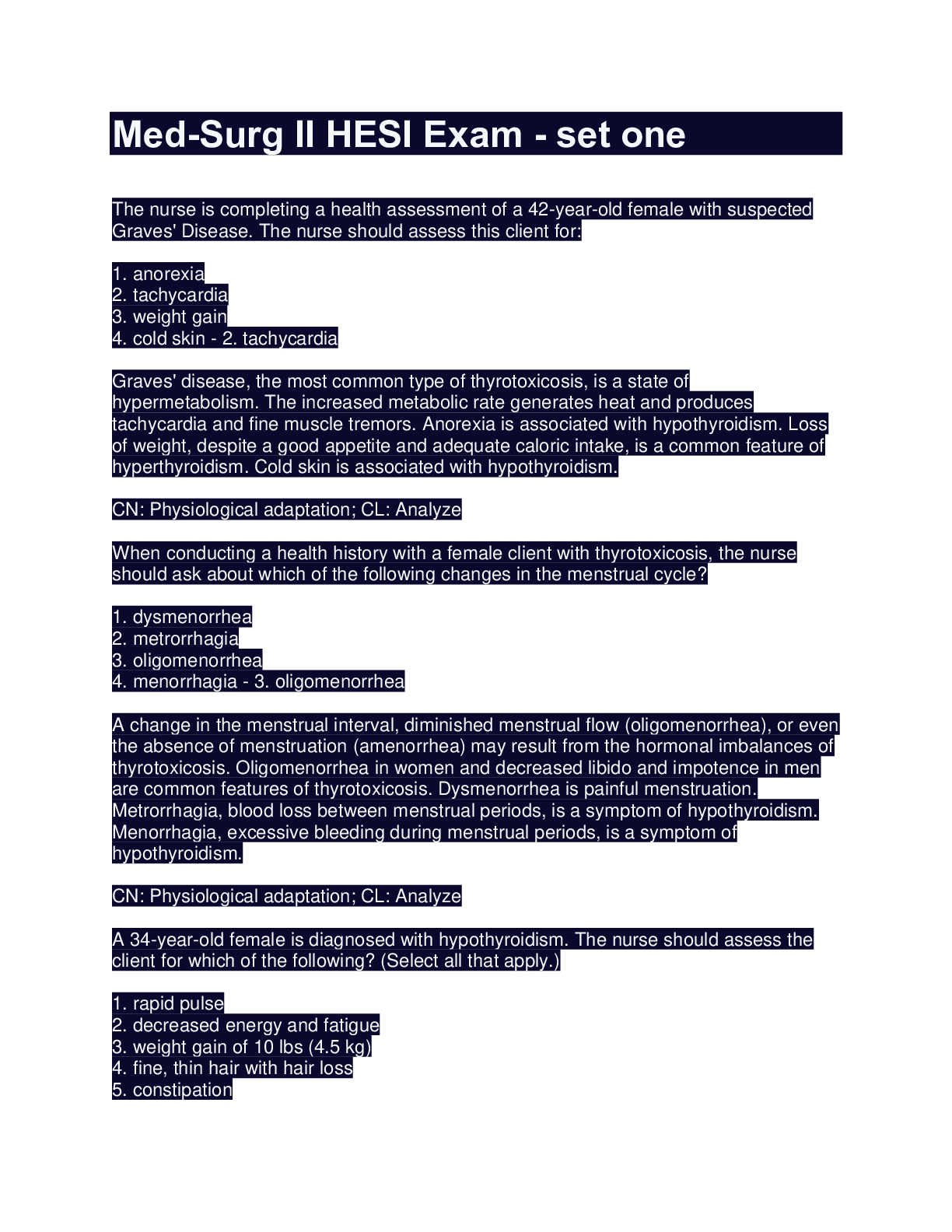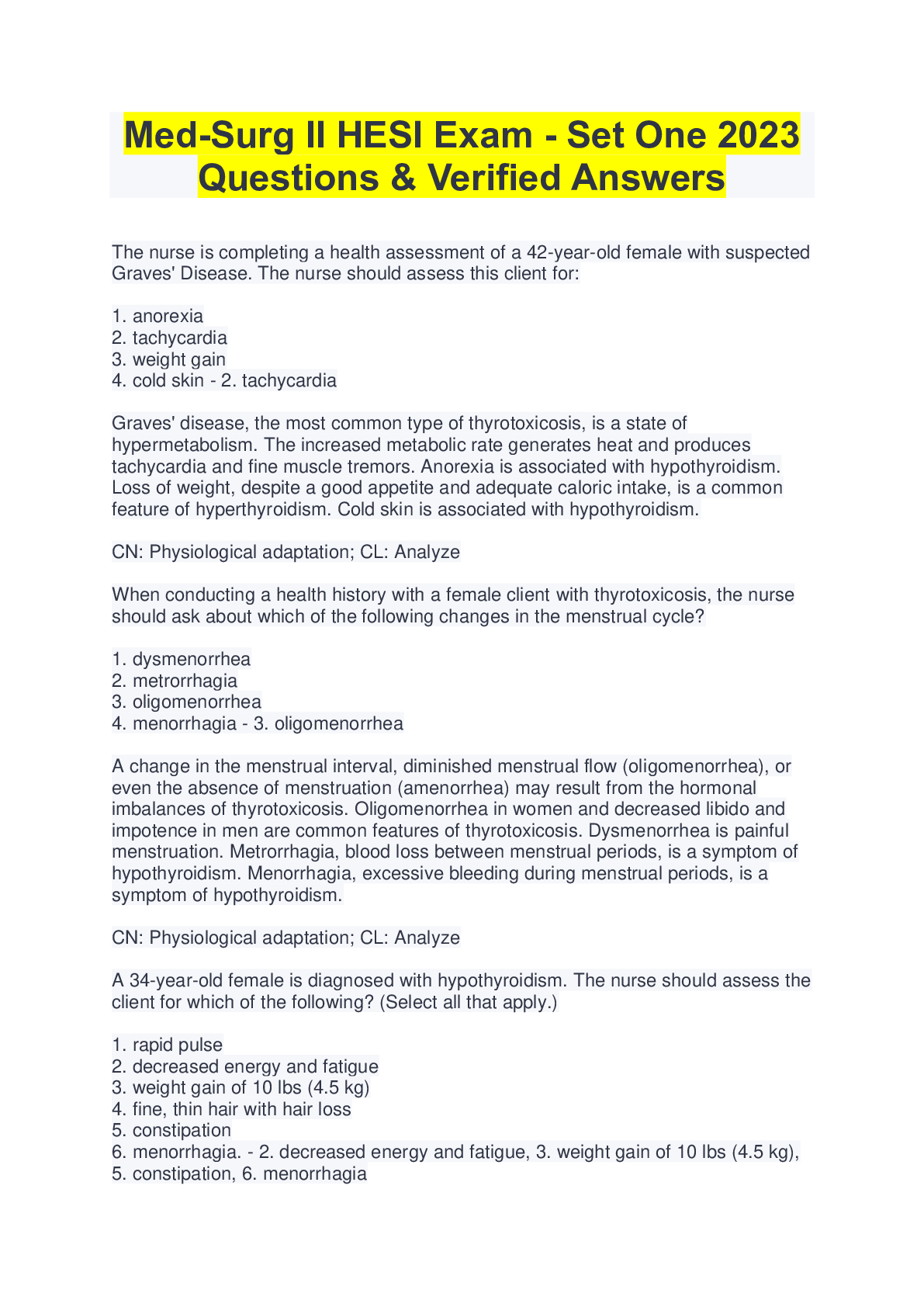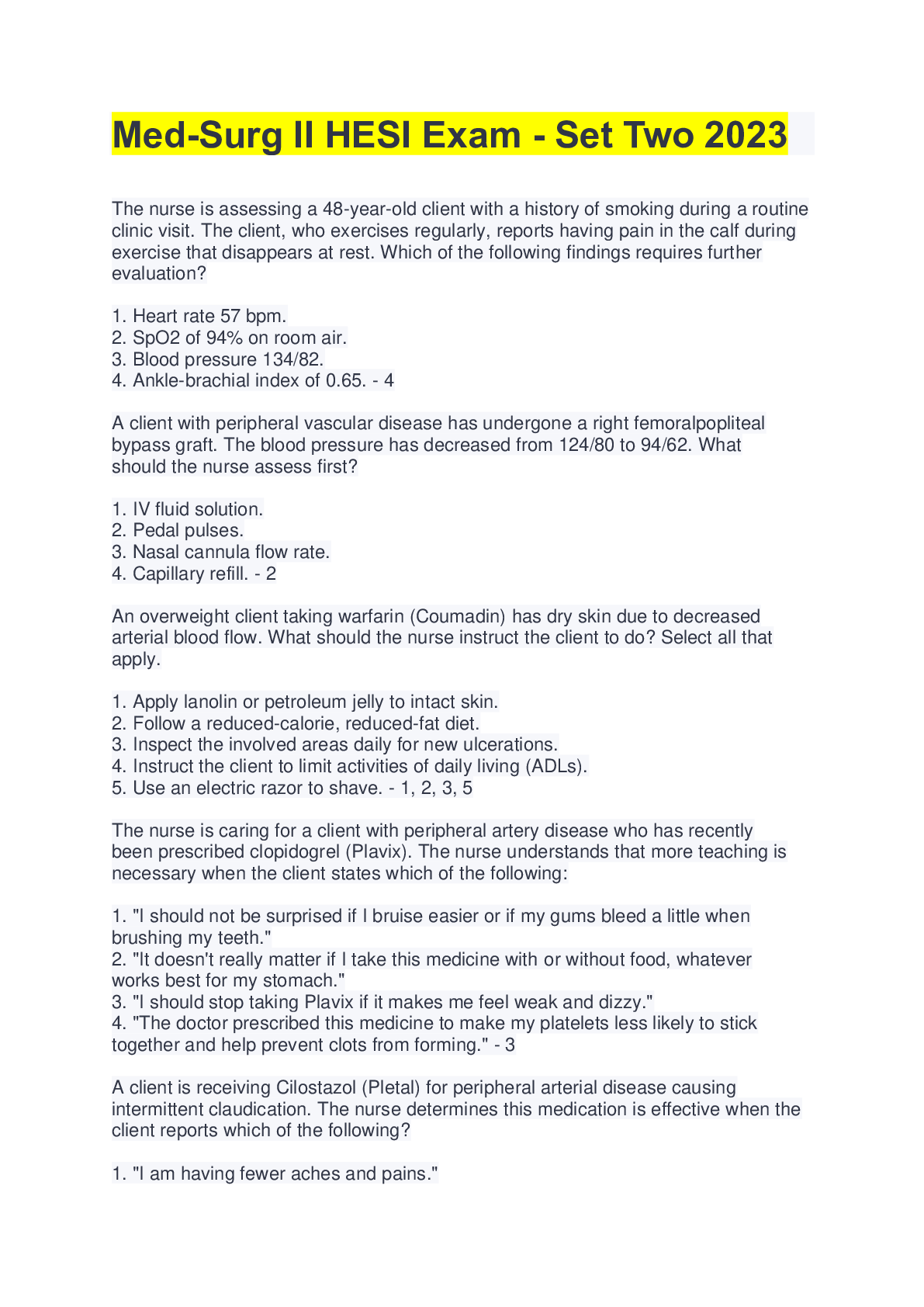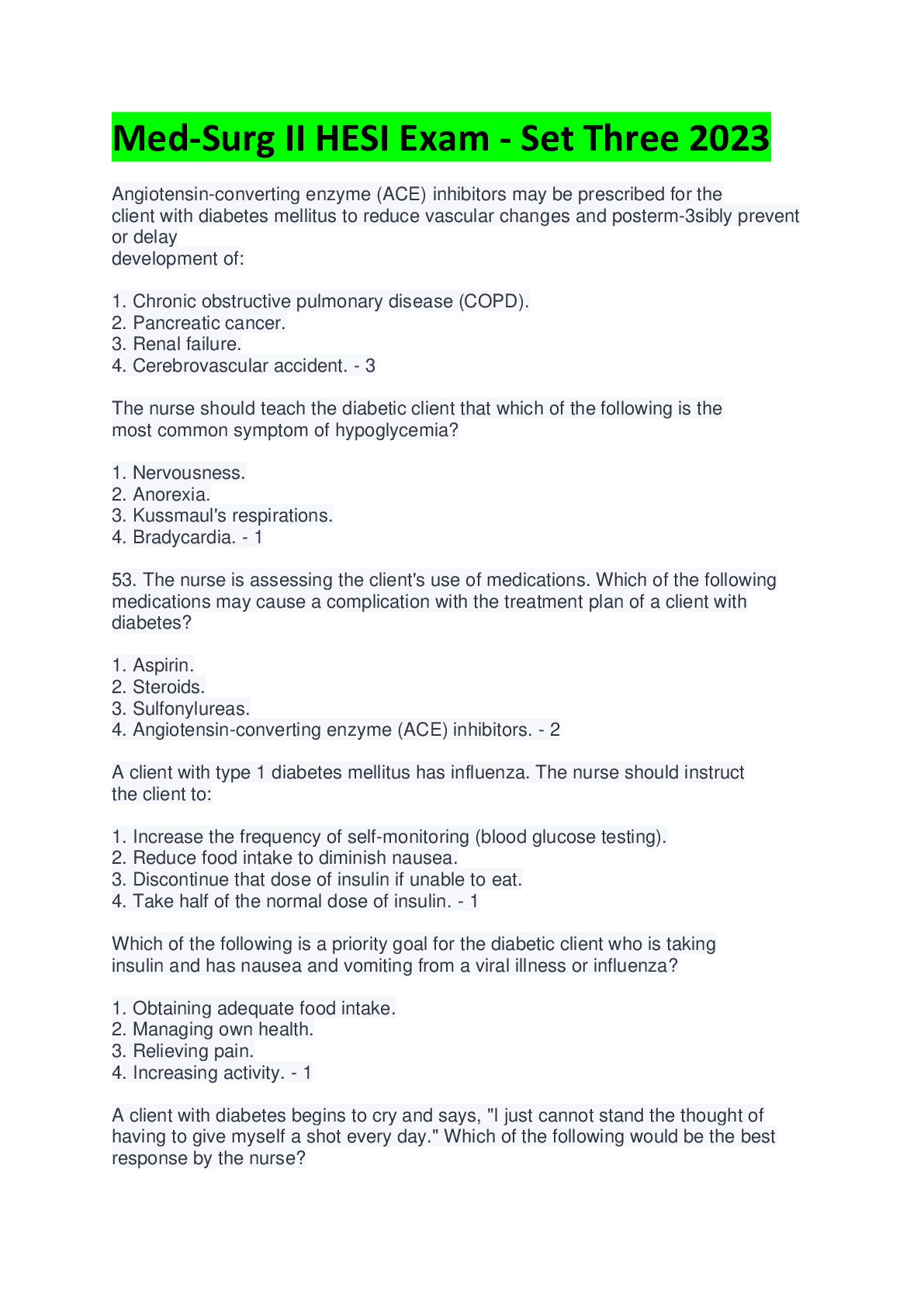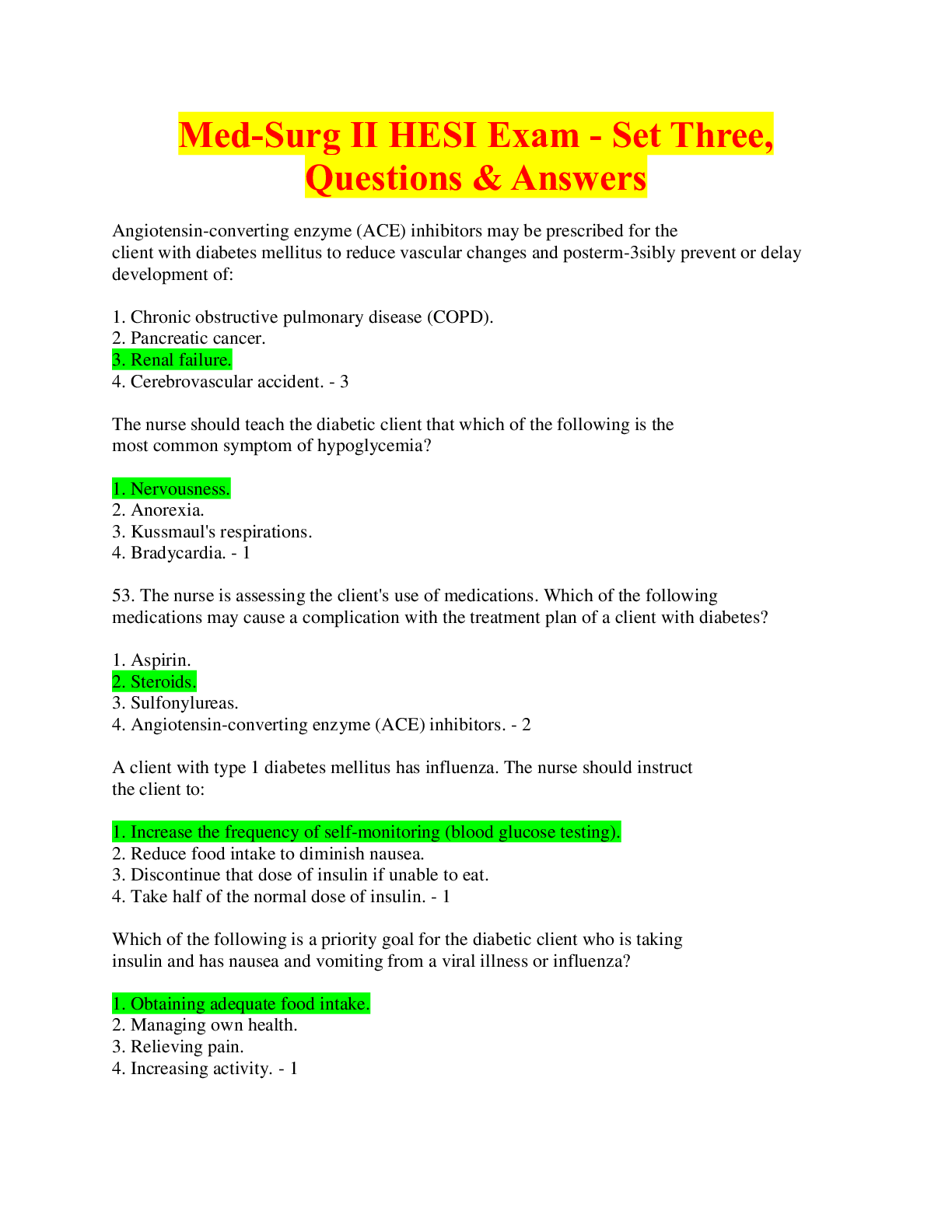Med-Surg II HESI Exam - Set One, Questions & Answers
Document Content and Description Below
Med-Surg II HESI Exam - Set One, Questions & Answers-A 34-year-old female is diagnosed with hypothyroidism. The nurse should assess the client for which of the following? (Select all that apply.) 1... . rapid pulse 2. decreased energy and fatigue 3. weight gain of 10 lbs (4.5 kg) 4. fine, thin hair with hair loss 5. constipation 6. menorrhagia. - 2. decreased energy and fatigue, 3. weight gain of 10 lbs (4.5 kg), 5. constipation, 6. menorrhagia Clients with hypothyroidism exhibit symptoms indicating a lack of thyroid hormone. Bradycardia, decreased energy and lethargy, memory problems, weight gain, coarse hair, constipation, and menorrhagia are common signs and symptoms of hypothyroidism. CN: Physiological adaptation; CL: Analyze A 60-year-old female is diagnosed with hypothyroidism. The nurse should assess the client for which of the following? 1. Tachycardia. 2. Weight gain. 3. Diarrhea. 4. Nausea. - Weight gain A client diagnosed with a deep vein thrombosis has heparin sodium infusing at 1,500 units/h. The concentration of heparin is 25,000 units/500 mL. If the infusion remains at the same rate for a full 12-hour shift, how many milliliters of fluid will infuse? __________________________-mL. - 360 mL A client diagnosed with primary (essential) hypertension is taking chlorothiazide (Diuril). The nurse determines teaching about this medication is effective when the client makes the following statement. "I will (Select all that apply.) 1. take my weight daily at the same time each day." 2. not drink alcoholic beverages while on this medication." 3. reduce salt intake in my diet." 4. reduce my dosage if I have severe dizziness." 5. use sunscreen if I have prolonged exposure to sunlight." 6. take the drug late in the evening." - 1. take my weight daily at the same time each day." 2. not drink alcoholic beverages while on this medication." 3. reduce salt intake in my diet." 5. use sunscreen if I have prolonged exposure to sunlight." A client has a nasogastric (NG) tube following a subtotal gastrectomy. The nurse should: 1. Irrigate the tube with 30 mL of sterile water every hour, if needed. 2. Reposition the tube if it is not draining well. 3. Monitor the client for nausea, vomiting, and abdominal distention. 4. Turn the machine to high suction if the drainage is sluggish on low suction. - 3. Monitor the client for nausea, vomiting, and abdominal distention. A client has an emergency embolectomy for an embolus in the femoral artery. After the client returns from the recovery room, in what order, from first to last, should the nurse provide care? 1. Administer pain medication. 2. Draw blood for laboratory studies. 3. Regulate the IV infusion. 4. Monitor the pulses. 5. Inspect the dressing. - 4. Monitor the pulses. 5. Inspect the dressing. 3. Regulate the IV infusion. 1. Administer pain medication. 2. Draw blood for laboratory studies. The nurse should first monitor the popliteal and the pedal pulses in the affected extremity after arterial embolectomy. Monitoring peripheral pulses below the site of occlusion checks the arterial circulation in the involved extremity. The nurse should next inspect the dressing to be sure that the client is not bleeding at the surgical site. The nurse should next regulate the IV infusion to prevent fluid overload. Then the nurse should assess pain and administer pain medications as prescribed. Last, the nurse can obtain blood for laboratory studies. A client has been diagnosed with adenocarcinoma of the stomach and is scheduled to undergo a subtotal gastrectomy (Billroth II procedure). During preoperative teaching, the nurse is reinforcing information about the surgical procedure. Which of the following explanations is most accurate? 1. The procedure will result in enlargement of the pyloric sphincter. 2. The procedure will result in anastomosis of the gastric stump to the jejunum. 3. The procedure will result in removal of the duodenum. 4. The procedure will result in repositioning of the vagus nerve. - 2. The procedure will result in anastomosis of the gastric stump to the jejunum. A client has been on long-term prednisone therapy. The nurse should instruct the client to consume a diet high in which of the following? Select all that apply. 1. Carbohydrate. 2. Protein. 3. Trans fat. 4. Potassium. 5. Calcium. 6. Vitamin D. - 2. Protein. 4. Potassium. 5. Calcium. 6. Vitamin D. A client has been taking aluminum hydroxide 30 mL six times per day at home to treat a peptic ulcer. The client has been unable to have a bowel movement for 3 days. Based on this information, the nurse would determine that which of the following is the most likely cause of the client's constipation? 1. The client has not been including enough fiber in the diet. 2. The client needs to increase the daily exercise. 3. The client is experiencing an adverse effect of the aluminum hydroxide. 4. The client has developed a gastrointestinal obstruction. - 3. The client is experiencing an adverse effect of the aluminum hydroxide. A client is admitted with a 6.5-cm thoracic aneurysm. The nurse records findings from the initial assessment in the client's chart, as shown below. At 10:30 AM, the client has sharp mid-chest pain after having a bowel movement. What should the nurse do first? 1. Assess the client's vital signs. 2. Administer a bolus of lactated Ringer's solution. 3. Assess the client's neurologic status. 4. Contact the physician. - 1. Assess the client's vital signs. A client is admitted with a diagnosis of thrombophlebitis and deep vein thrombosis of the right leg. A loading dose of heparin has been given in the emergency room, and IV heparin will be continued for the next several days. The nurse should develop a plan of care for this client that will involve: 1. Administering aspirin as prescribed. 2. Encouraging green leafy vegetables in the diet. 3. Monitoring the client's prothrombin time (PT). 4. Monitoring the client's activated partial thromboplastin time (aPTT) and International Normalized Ratio (INR). - 4. Monitoring the client's activated partial thromboplastin time (aPTT) and International Normalized Ratio (INR). A client is admitted with an acute onset of shortness of breath. A diagnosis of pulmonary embolism is made. One common cause of pulmonary embolism is: 1. Arteriosclerosis. 2. Aneurysm formation. 3. Deep vein thrombosis (DVT). 4. Varicose veins. - 3. Deep vein thrombosis (DVT). A client is on complete bed rest. The nurse should assess the client for risk for developing which of the following complications? 1. Air embolus. 2. Fat embolus. 3. Stress fractures. 4. Thrombophlebitis. - 4. Thrombophlebitis. A client is receiving an IV infusion of 5% dextrose in water (D5W). The skin around the IV insertion site is red, warm to touch, and painful. The nurse should first: 1. Administer acetaminophen (Tylenol). 2. Change the D5W to normal saline. 3. Discontinue the IV. 4. Place a warm compress on the area. - 3. Discontinue the IV. A client is scheduled for an elective splenectomy. Immediately before the client goes to surgery, the nurse should determine that the client has: 1. Voided completely. 2. Signed the consent. 3. Vital signs recorded. 4. Name band on wrist - 3. Vital signs recorded. A client is taking an antacid for treatment of a peptic ulcer. Which of the following statements best indicates that the client understands how to correctly take the antacid? 1. "I should take my antacid before I take my other medications." 2. "I need to decrease my intake of fluids so that I don't dilute the effects of my antacid." 3. "My antacid will be most effective if I take it whenever I experience stomach pains." 4. "It is best for me to take my antacid 1 to 3 hours after meals." - 4. "It is best for me to take my antacid 1 to 3 hours after meals." A client is taking clonidine (Catapres) for treatment of hypertension. The nurse should teach the client about which of the following common adverse effects of this drug? Select all that apply. 1. Dry mouth. 2. Hyperkalemia. 3. Impotence. 4. Pancreatitis. 5. Sleep disturbance. - 1. Dry mouth. 3. Impotence. 5. Sleep disturbance. Clonidine (Catapres) is a central-acting adrenergic antagonist. It reduces sympathetic outflow from the central nervous system. Dry mouth, impotence, and sleep disturbances are possible adverse effects. Hyperkalemia and pancreatitis are not anticipated with use of this drug. A client is to be discharged on prednisone. Which of the following statements indicates that the client understands important concepts about the medication therapy? 1. "I need to take the medicine in divided doses at morning and bedtime." 2. "I am to take 40 mg of prednisone for 2 months and then stop." 3. "I need to wear or carry identification that I am taking prednisone." 4. "Prednisone will give me extra protection from colds and flu." - 3. "I need to wear or carry identification that I am taking prednisone." [Show More]
Last updated: 3 months ago
Preview 1 out of 24 pages
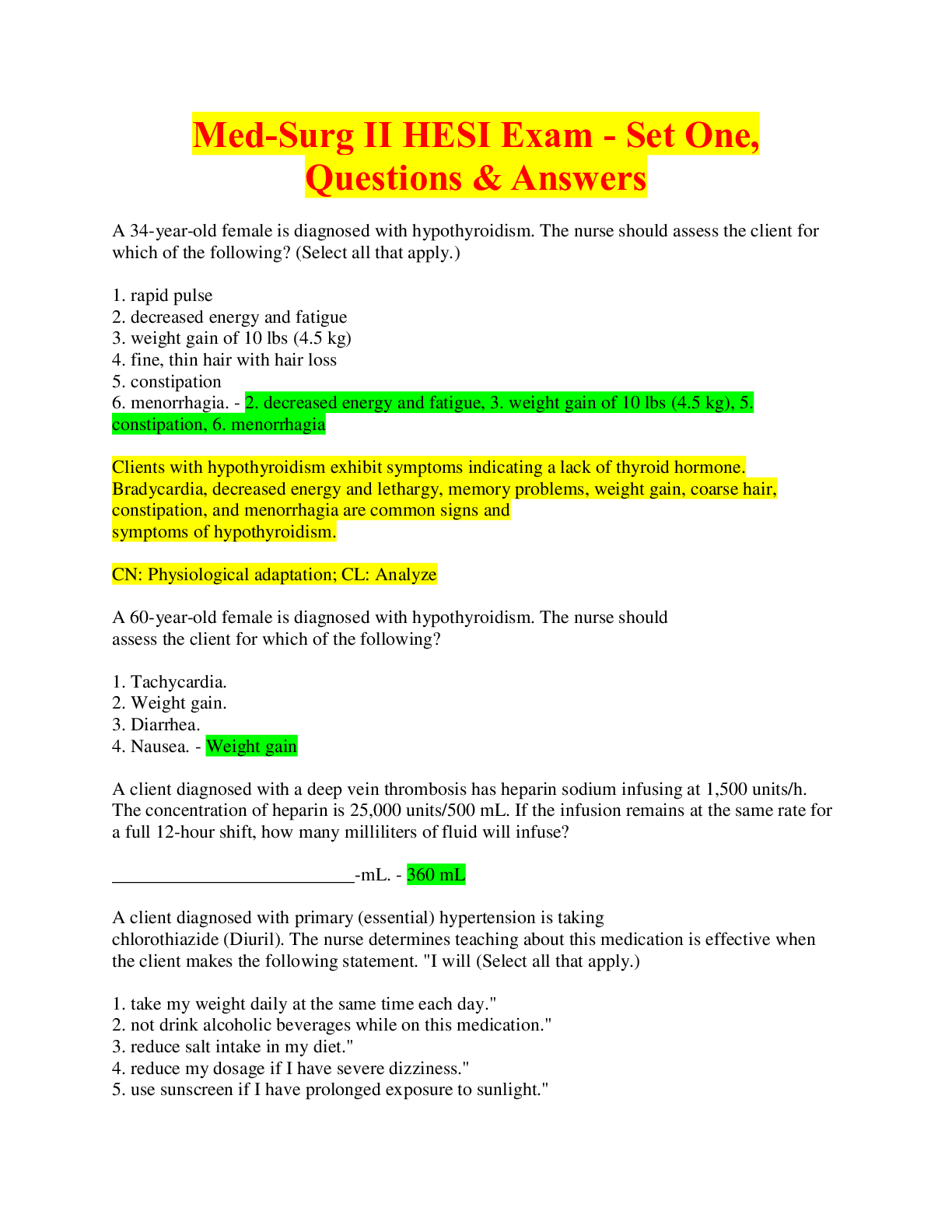
Buy this document to get the full access instantly
Instant Download Access after purchase
Add to cartInstant download
We Accept:

Reviews( 0 )
$14.50
Document information
Connected school, study & course
About the document
Uploaded On
Mar 10, 2024
Number of pages
24
Written in
Additional information
This document has been written for:
Uploaded
Mar 10, 2024
Downloads
0
Views
13






